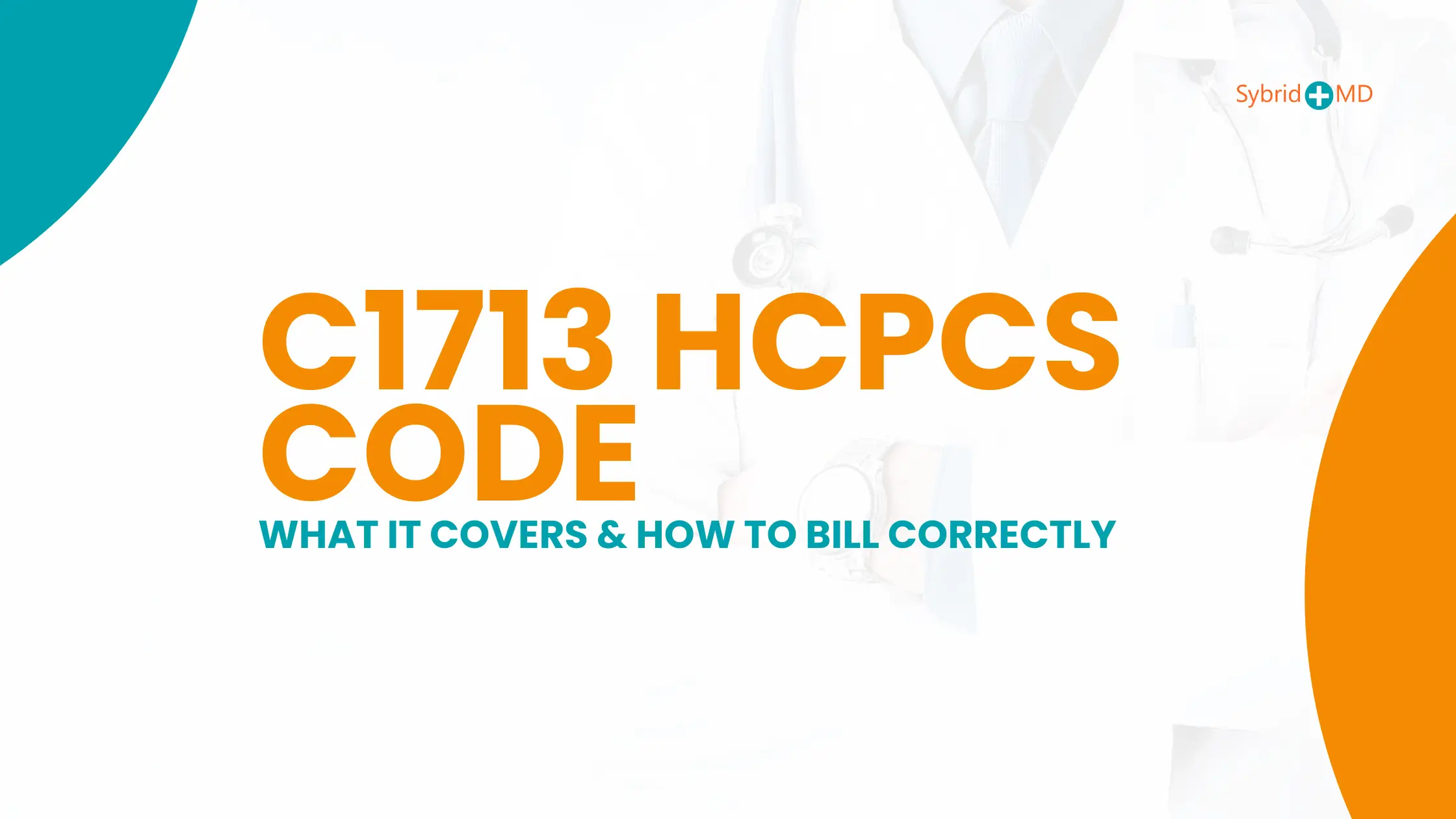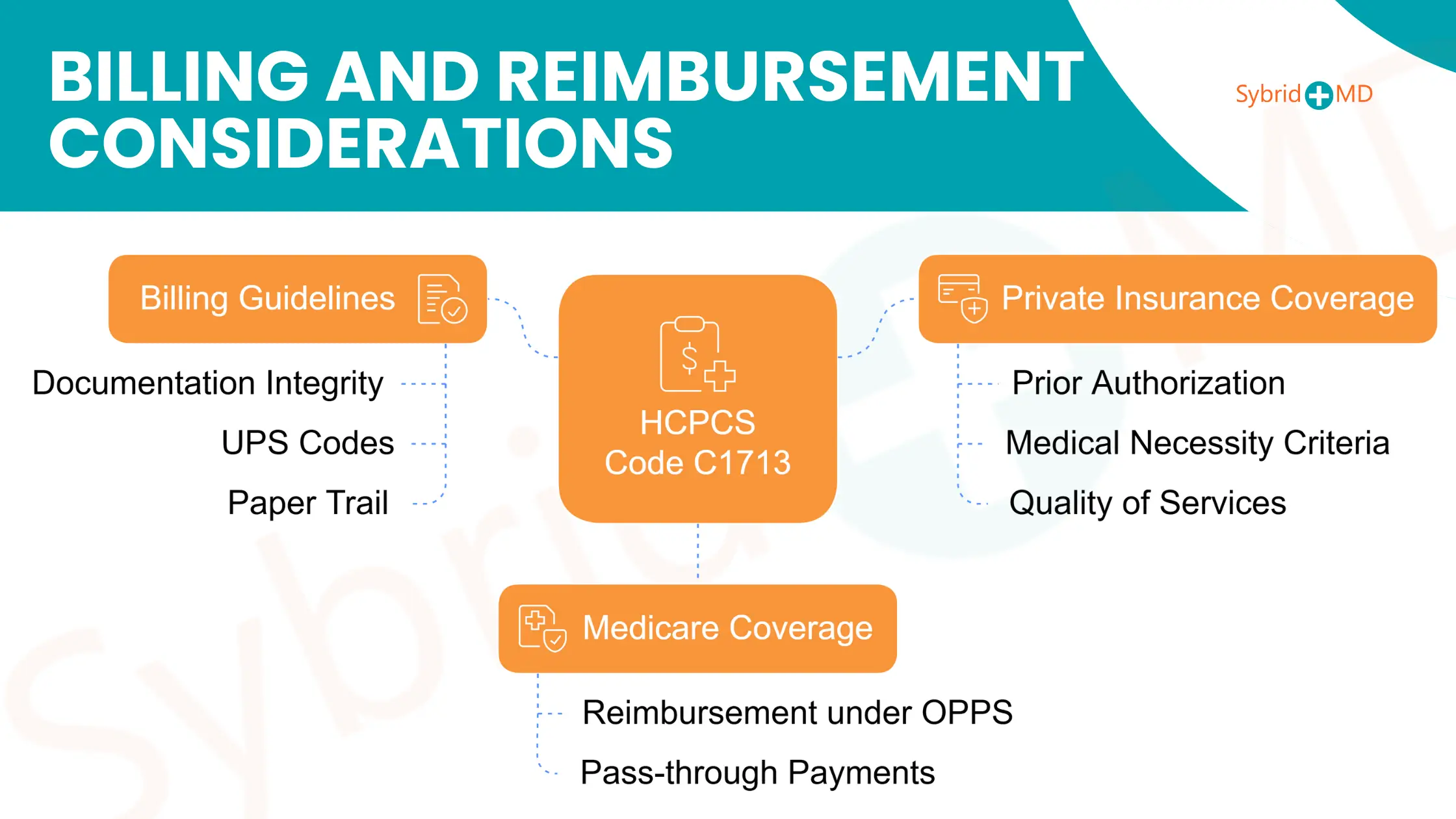HCPCS stands for Healthcare Common Procedure Coding System and is quite similar to ICD, which is the International Classification of Diseases; HCPCS is a common system used in billing that has rules for recognizing medical procedures, supplies, and devices. Among those prosthetic implants, there is HCPCS Code C1713 which involves implant absence or replacement of screws or anchors used in bone-to-bone or soft tissue-to-bone fixation. This paper aims to discuss HCPCS Code C1713 on the following indicators: definition, usage, billing, and reimbursement.
Understanding HCPCS Code C1713
Definition and Description
HCPCS Code C1713 is particularly used to refer to implantable medical devices that can be used during surgeries in joining bone-to-bone or soft tissue-to-bone processes. It is defined as:
“Screw type fastener used in place of bone to bone or soft tissue to bone application, implantable type.”
This means that this group encompasses screws used for surgical purposes used in orthopedic, reconstructive, and maxillofacial surgeries and other forms of anchoring tools. Some of its uses are to immobilize bone fracture areas and fix soft tissues to bones, such as tendons and ligaments, for the tissues to heal and regain their functions.
Key Features and Functionality
The functions of the C1713-coded devices are mainly to:
- Strengthen Muscles: Strengthen the muscles in order to support the bones in the joint hence giving support to the muscles that were damaged.
- Support Bone Healing: They help in keeping fractured or the segments of bone that are operated on to be held in place to aid in bone healing process.
- For Reinforcing & Reinforcing Ligaments: It is very useful in cases of ligament or tendon reconstruction, particularly if the bone-tendon interface needs to be strongly secured.
Surgical Applications of C1713 Implantable Screws
C1713 coded screws and anchors apply to several procedures carried out on the musculoskeletal system, notably Dealer In orthopedic and reconstructive surgeries.
Fracture Fixation
- Orif: Screws and anchors are used for fractures throughout the body but more so for complicated fractures of the hip, ankle, wrist, and long bones.
- Craniofacial and Maxillofacial Surgery: Application of maxillofacial screws in fixation of a fractured jaw, skull, or facial bones that have been injured during trauma or for surgical intervention.
Ligament and Tendon Repair
- Rotator Cuff Repair: Sutures utilized when repairing the rotator cuff tendons involve implantable anchors for the tendons to be attached to the humeral head.
- Knee Implants: Anchors and screws are employed in surgeries that involve replacing the anterior cruciate ligament or ACL with the help of a graft.
- Achilles Tendinopathy: Repair of an Achilles tendon tear, also called Aubert’s operation, linking the tendon to the portion of the calcaneus bone.
Spinal Stabilization
- Spinal Fusion Surgery: Screws are used when attempting to join parts of the vertebral column that have been harmed through surgery, deformity, or disc degeneration.
- Spinal fusion: Applicable in the case of injuries to the spine or osteoporosis to bring back the stability of the spine.
Material and Design Considerations
The second is the materials used in the manufacturing of the HCPCS C1713 – coded implants which include biocompatible materials.
- Tin or Tin Alloys: Lightweight, highly durable, and anti-corrosive material, which is ideal for orthopedic implant use.
- Temporary Implant Material: This type of implant material is commonly characterized by strength and stability, and is often used mostly in Load bearing applications.
- Bioabsorbable Polymers: Long term device – Bioabsorbable polymers which make it easier to have a slow degradation of the material and eventual absorption in the body without the need to remove the implant.
Clinical Applications of C1713 Devices
Primary Medical Uses
Various forms of equipment that fall under HCPCS C1713 are commonly used in;
- Fracture Management: A technique in which fractured bones are aligned in proper anatomical positions so that they may be firmly fixed.
- Ligament and Tendon Reattachment: Surgery in cases of ligament injury or avulsion of tendons, it involves fixing the torn tissue to the bone.
- Surgery for scoliosis: Helping in surgery for the realignment of scoliotic spine or in the occasion of vertebrate fractures, dislocations.
- Surgical Operations of Orthopedics: In knee, shoulder, and ankle joint arthroscopic operations where ligament reconstruction is frequent.
Common Procedures Utilizing HCPCS C1713 Devices
- Open Reduction and Internal Fixation (ORIF): It refers to the operation that involves the treatment of fractures through the use of screen-plate technology.
- Anterior Cruciate Ligament (ACL) Reconstruction: especially in the clinical practice of grafts for reconstructive knee ligament surgery.
- Arthroscopic rotator cuff repair: Re-suspension of the rotator cuff torn tendons into the humeral head with the help of anchors.
- Spinal Fusion Surgery: It is a surgical procedure which involves the application of screws to join two vertebral in order to strengthen the spinal column.
- Achilles tendon Repair: Fixation of the Achilles tendon to the calcaneus bone after a rupture.
Billing and Reimbursement Considerations
Medicare Coverage for C1713
HCPCS Code C1713 is usually reimbursable under the Medicare OPPS, provided that it was employed in a hospital outpatient setting. However, Medicare may consider this code as a pass through at some time but it pays little at other times and hence it is advisable to check with CMS frequently.
Billing Guidelines for C1713
In order to have the reimbursement of claims cleared correctly, the healthcare providers must meet the following:
- Documentation Integrity and Payment Coding: It must be coded synchronously with the medical code C1713.
- UPS codes: Device to Procedure Code: Ensuring that proper device to any procedure code as put down by CMS in order to avoid cases of rejection of the claim.
- Paper Trail: Presenting written evidence and records on the need for the implantable medical device.
Private Insurance Coverage
There may be more differences in the billing practices of private insurance for HCPCS C1713, and these are:
- Prior Authorization: One would require prior authorization for procedures that entail the implantation of anchors or screws.
- Medical Necessity Criteria: Justification of the implant’s necessity through detailed operative reports.
- Quality of Services: Some underlying policies may limit the amount of coverage that providers receive based on the type of procedures done or the indication of the procedures.
Surgical Implementation of C1713 Devices
Preoperative Considerations
The essential procedures that one must take before a surgical procedure for placing a C1713-qualifying device are:
- Preoperative Assessment: Evaluating the patient’s bone quality, joint stability, and overall health.
- Includes but is not limited to Imaging Studies: Using X-ray, CT scans, or MRI to determine the place of the implant.
- Informed Consent: Assisting the patient in understanding common law and what is being done, what the dangers are, and what future results will be.
Surgical Procedure Overview
The use of a C1713-coded device in a surgical procedure that is standard entails:
- Surgery and Anesthesia: Depending on the operation options, general or regional anesthesia would be administered based on the degree of invasiveness of the procedure.
- Surgical Incision: Accessing the target bone or soft tissue for implant placement.
- Modification of the Implant Site: Removal of any tissue that may be within the area of the implant or creation of deeper groves to accommodate for the screw or anchor.
- Stabilization: Immobilizing the bone through the use of the screw/anchor after a break in any of the bones or to hold tendons/ligaments in position.
- Wound Closure and Dressing: Suturing the cut made and then applying other bandages as probably allowed or required after surgery.
Postoperative Recovery and Care
Some of the procedures that one has to undertake are as follows after a C1713 device has been implanted in his or her body:
- Immediate Monitoring: Observation for complications such as infections or implant displacement.
- OPEN-AI 2: Physical Therapy: physiotherapy services that assist in regaining of body functions and movement.
- Follow-Up Assessments: Practice check-ups through X-ray to determine the status of the implants
Conclusion
Orthopedic, spinal, and sports medicine surgeries could not be performed without HCPCS Code C1713 code, as it offers stability to bones and soft tissues. Many clients are enrolled in Medicare and private insurance. Those insurance policies, proper coding, billing, and documentation are crucial to getting the correct payment for the bill. There is a need for healthcare practitioners to get more acquainted with CMS updates and insurance policies in order to get the most out of C1713 code devices in practice.
Frequently Asked Questions (FAQs)
How much is CPT code C1713?
The cost of CPT code C1713 will hence depend on hospital bar, insurance reimbursement, and geographic location. Pricing for this code is based on the manufacturer and the procedure where this code is used, which is an implantable anchor or screw. It is recommended to ask the healthcare providers, insurance plans, or insurance companies for an accurate cost estimation and for further coverage information.
What is the HCPCS code for a portable CPAP machine?
The type of portable respiratory ventilator is referred to as Continuous Positive Airway Pressure and the HCPCS code assigned to it is E0601. This medication code is applicable to billing and reimbursement of CPAP devices that are used by OSA and other respiratory disorder patients.
What is the HCPCS code for a bone stimulator?
The bone stimulators are categorized within the HCPCS codes according to the scope of the product:
- E0747: External bone growth stimulator
- E0749: Implanted bone growth stimulator
These devices are used in bone growth stimulation in cases of non-union of fractures, spinal fusion or delayed bone healing.
What is the HCPCS Level C code?
HCPCS LEVEL C codes are special codes that are applicable under OPPS from C1713 – C9899. These codes are assigned to:
- Medical implants and devices
- Certain drugs
- Hospital outpatient services
HCPCS Level C codes are mainly used for the hospital outpatient and may be updated or replaced over some time.
Is C1713 covered by Medicare?
Yes, Medicare with Hospital Outpatient Prospective Payment System (OPPS) includes C1713 as one of the codes for payments. Coverage and reimbursement depend on:
- The medical necessity and evidence of the clinical requirement
- CMS guidelines and updates
- Local Medicare Administrative Contractors (MACs) policies
The providers should check Medicare’s current rules of payment with the C1713 code to submit correct charges on implantable devices.
Is C1713 considered an implant?
Yes, C1713 can be considered as a form of implantable medical device. It covers anchors and screws that are implants used to fix fractures or screws used to suture soft tissue such as the tendons, ligaments to bones. These implants are widely applied in orthopedic and spinal operations and reconstruction procedures as well.


